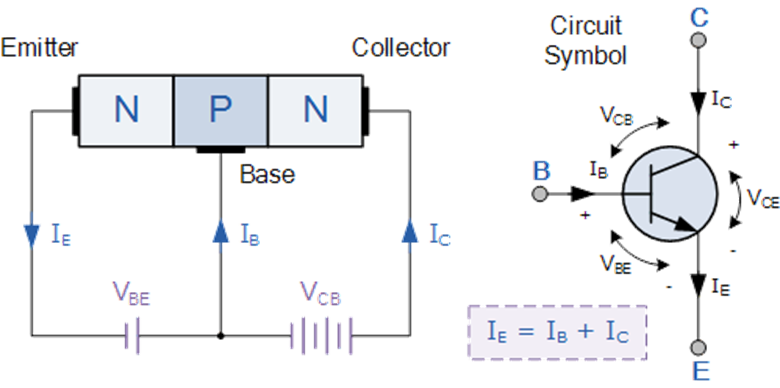
In NPN transistors,
Answer
498.9k+ views
Hint: First of all find out the emitter current. After that find out the collector current using the formula
Complete step by step answer:
Current amplification factor in a bi junction transistor is described as the ratio of output current to its input current. In the common base configuration, current amplification factor is given as the ratio of collector current to the emitter current. The low current travels from the voltage source into the transistor base. The current at the base will turn on the transistor. Then the current is amplified and travels from the emitter of the transistor to the collector. This is how current amplification takes place in a bi junction transistor. The amplifier is a very complex circuit which is using properties of a transistor.
Here let us first write what all are given in the question.
Number of electrons entering emitter,
Time taken=
Therefore the current in the emitter is
Since only 2% current is lost, therefore 98% will reach the collector
So
And also we know that
Therefore the collector current will be,
Also the current amplification factor will be,
Hence the correct answer is given by the option A.

Note:
MOSFETs are controlled by voltage not on their own. It is used to amplify current using a MOSFET by passing the input current through a resistor there by converting the current signal to a voltage. This signal voltage is controlling the MOSFET, which gives an output signal current.
Complete step by step answer:
Current amplification factor in a bi junction transistor is described as the ratio of output current to its input current. In the common base configuration, current amplification factor is given as the ratio of collector current to the emitter current. The low current travels from the voltage source into the transistor base. The current at the base will turn on the transistor. Then the current is amplified and travels from the emitter of the transistor to the collector. This is how current amplification takes place in a bi junction transistor. The amplifier is a very complex circuit which is using properties of a transistor.
Here let us first write what all are given in the question.
Number of electrons entering emitter,
Time taken=
Therefore the current in the emitter is
Since only 2% current is lost, therefore 98% will reach the collector
So
And also we know that
Therefore the collector current will be,
Also the current amplification factor will be,
Hence the correct answer is given by the option A.

Note:
MOSFETs are controlled by voltage not on their own. It is used to amplify current using a MOSFET by passing the input current through a resistor there by converting the current signal to a voltage. This signal voltage is controlling the MOSFET, which gives an output signal current.
Latest Vedantu courses for you
Grade 10 | CBSE | SCHOOL | English
Vedantu 10 CBSE Pro Course - (2025-26)
School Full course for CBSE students
₹35,000 per year
Recently Updated Pages
Master Class 12 Business Studies: Engaging Questions & Answers for Success

Master Class 12 English: Engaging Questions & Answers for Success

Master Class 12 Social Science: Engaging Questions & Answers for Success

Master Class 12 Chemistry: Engaging Questions & Answers for Success

Class 12 Question and Answer - Your Ultimate Solutions Guide

Master Class 12 Economics: Engaging Questions & Answers for Success

Trending doubts
Give 10 examples of unisexual and bisexual flowers

Draw a labelled sketch of the human eye class 12 physics CBSE

Differentiate between homogeneous and heterogeneous class 12 chemistry CBSE

Write a short note on Franklands reaction class 12 chemistry CBSE

Differentiate between insitu conservation and exsitu class 12 biology CBSE

What are the major means of transport Explain each class 12 social science CBSE




